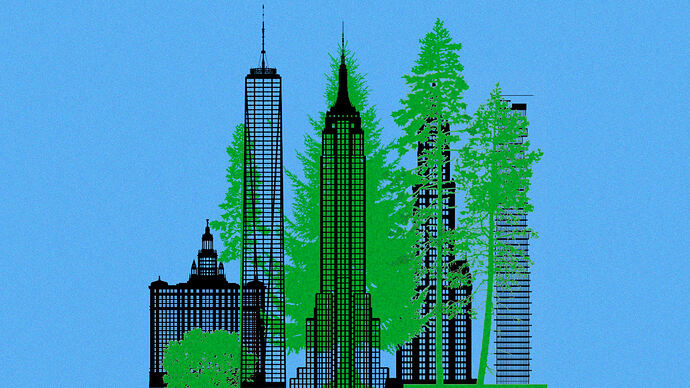The same survival characteristics found in trees and forests can be applied to developing new cities.
We just finished the hottest July in history, and cities are largely to blame. Today, cities contribute 60 percent of the total amount of greenhouse gases that pollute our atmosphere and are a significant player in generating rapid climate change. The construction materials currently used to build skyscrapers—concrete, steel, and glass—are responsible for nearly 20 percent of the total greenhouse gases cities create.
For practical solutions to these problems, we need to look no further than trees. The same survival characteristics found in trees and forests can be applied to developing new cities. Cities emulating natural processes is an example of “biomimicry.”
In my vision for the new city, every building will, like trees, mimic nature to sequester carbon, harvest rainwater, generate food, and utilize renewable nonpolluting energy sources, which is precisely what trees in a forest do every day. In addition, our new city’s buildings, like trees, will “talk” to each other and share resources such as water, energy, and food.
Carbon sequestration is critical to restoring the Earth’s atmosphere to a time back before the discovery of fossil fuels. But how could a city, simply by choosing a specific construction material, help it to store carbon? It sounds improbable, but everything changed with the invention of a building material called cross-laminated timber (CLT).
We can now construct a skyscraper, or any other building, using an engineered wood product, CLT. It has the same density as a tree trunk, making it highly resistant to destruction by fire. Proof of concept—check out the aftermath of a forest fire, and what do you see? The trunks of trees are still standing. That is because fire needs oxygen, and the high density of the trunk, shortly after fire breaks out, stops the flame dead in its tracks. Trees char but do not burn to the ground. Because of this feature, CLT is gaining popularity worldwide as a renewable, abundant, safe-to-use construction material. In addition, mass plywood and mass bamboo have recently emerged as optional CLT-like building products.
CLT is twice as light and twice as strong as a similar volume of concrete, and unlike concrete, CLT can be easily re-purposed. It is typically designed and cut to shape off-site and then delivered to the construction site, often within the same week, allowing for rapid incorporation into the structure. Urban buildings made of CLT will contribute to reversing climate change simply by sequestering carbon instead of increasing their carbon footprint.
Trees harvest rainwater by storing it in their roots. Cities can emulate this as well. New York City gets an average of 47 inches of rain each year, equivalent to nearly 250 billion gallons of freshwater. That is over half of what New Yorkers consume in a year, and yet none of the rainwater that falls on the Big Apple is captured. If it did catch and store what nature provides free of charge, water shortages would be a thing of the past. In Bermuda, for example, 63,000 people live a good life dependent entirely upon rainwater.
“imagine how much electricity skyscrapers built with photovoltaic cells could generate by capturing a fraction of the sun’s energy each morning, just as the trees do.”
Trees’ food production supports many forest creatures providing them with fruits, nuts, and leaves. And, inspired by the food production processes of trees, indoor farming within each new city building could supply enough fresh produce daily to feed its entire population. It might even grow enough for export, depending on the food items. Now a $7 billion industry, vertical farming is catching on worldwide and could eventually enable every city to become a food supplier.
Finally, trees convert sunlight into chemical energy via photosynthesis, and cities can also mimic this. Energy remains the biggest stumbling block to setting the built environment free from traditional, centralized energy schemes. But recent progress in photovoltaics has introduced the revolutionary concept of converting clear glass windows into functional energy-producing photovoltaic cells. The technology has advanced so quickly that some transparent photovoltaic cells are now commercially available. If, as anticipated, this breakthrough leads to a practical, affordable, energy-efficient product, imagine how much electricity a modern city filled with skyscrapers built with photovoltaic cells could generate by capturing a fraction of the sun’s energy each morning, just as the trees do.
Sometimes the solutions to some of the world’s most challenging problems are right before our eyes. The future of cities is bright if we can learn from nature and base urban design on something as useful as a tree.
Dickson D. Despommier is an emeritus professor at Columbia and the author of The New City: How to Build Our Sustainable Urban Future (Columbia University Press).
